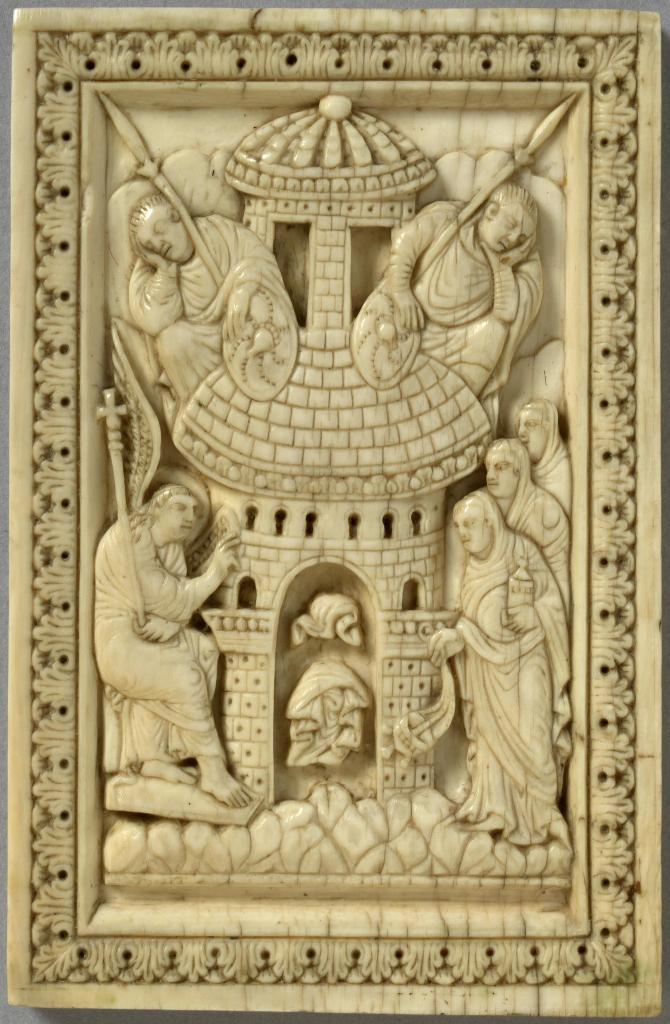Create an Amazon Wedding Registry

Create an Amazon Wedding Registry
Ivory Book-Cover of Women and Soldiers at the Sepulchre.
St. Gallen, 10th century. Victoria and Albert Museum.

A detail of the soldiers on the Ivory Book-Cover, St. Gallen, 10th century, Victoria and Albert Museum
The Maries at the Sepulchre
Object: Panel
Place of origin: St Gallen (probably, made)
Date: ca. 900-950 (made)
Artist/Maker: Unknown
Materials and Techniques: Ivory
Museum number: 380-1871
Physical description:
Ivory plaque carved in sunken relief. The sepulchre is represented as a round building with dome and cupola.
An angel sits on the left of the tomb, addressing the three Maries as they approach and holding a tall cross-sceptre in his left hand.
Above his right hand there appears to be an indistinct, single-word inscription.
The first of the Maries carries a censer and a pot of spices to anoint Jesus. Above are two soldiers, who appear to be sleeping on the roof of the tomb.
In the background are hillocks in low relief. The ground on which the scene takes place does not meet the lower border, as in most reliefs, but sits on a parallel step above it.
The border is of small acanthus leaves separated by fine single drill holes.
Dimensions: Height: 9.3 cm, Width: 6 cm, Depth: 0.7 cm, Weight: 0.06 kg
Object history note:
The plaque is closely connected in size, figure style, ground and border decoration to two other panels, one showing the Annunciation (Berlin),
the other the Ascension (Liverpool).
The three panels with a fourth - now missing, of the Crucifixion - very likely originally belonged to a book-cover, probably a Gospels or Evangelistary.
The place of production of St. Gallen or the Upper Rhine is suggested, as the drapery of the angel is similar to those on the ivory cover of Codex 53 at St Gallen,
associated with the monk-craftsman Tuotilo and probably carved in about 900. Goldschmidt (Goldschmidt, 1914)
pointed out that there is also a pen-and-ink drawing at St Gallen executed by the scribe Hartker (986-1017) of a remarkably similar scene of the Maries at the Sepulchre,
which might have been drawn from an ivory model. The drawing is not a copy of the present plaque though.
It might rather be that an influential prototype existed in St Gallen, which served as a model for both works.
Historical significance: Carolingian ivories and manuscripts often featured similar styles and compositions.
This ivory was probably carved at the Benedictine abbey of St Gallen, an important centre of manuscript and ivory production.
The same design can be seen in manuscripts made at
the abbey. It shows the Virgin Mary and her two companions finding Christís empty tomb.
Victoria and Albert Museum
Referenced on p.21, The Age of Charlemagne (Men-at-Arms 150) by D.Nicolle, A.McBride
A late 10th-century south German ivory book-cover showing the spear and shield which remained the basic equipment of most early medieval warriors. (V & A Museum, no. 380-1871, London)
See also the Basilewsky Situla, Soldiers at the Sepulchre. Ottonian Milan, Italy, c.980AD, Victoria and Albert Museum
10th Century Illustrations of Costume and Soldiers
Carolingian Illustrations of Costume and Soldiers


